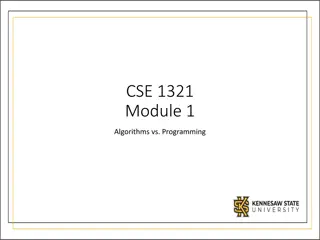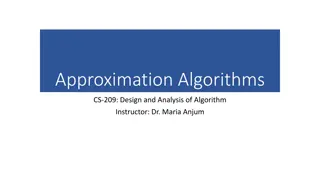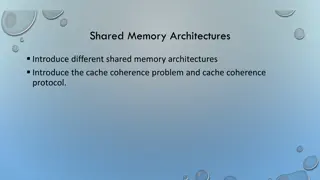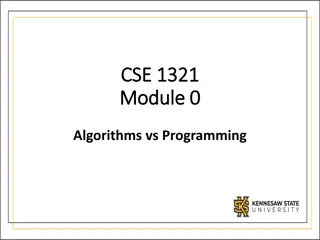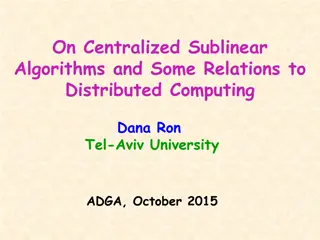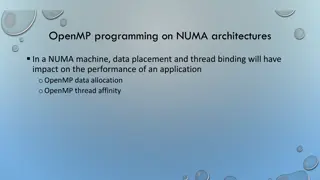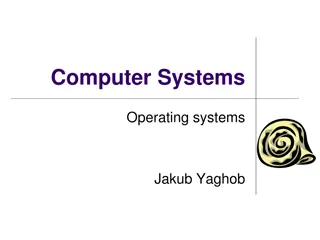Introduction to PRAM Architectures and Algorithms
This content covers Parallel Random Access Machine (PRAM) architectures, algorithms, and performance evaluation. It discusses shared memory models, PRAM processors, network models, and provides definitions related to parallel computation. Insight from experts Joseph F. JaJa and Uzi Vishkin is included, along with discussions on speedup, efficiency, Amdahl's Law, and examples like Matrix-Vector Multiplication (Mvm).
Download Presentation

Please find below an Image/Link to download the presentation.
The content on the website is provided AS IS for your information and personal use only. It may not be sold, licensed, or shared on other websites without obtaining consent from the author.If you encounter any issues during the download, it is possible that the publisher has removed the file from their server.
You are allowed to download the files provided on this website for personal or commercial use, subject to the condition that they are used lawfully. All files are the property of their respective owners.
The content on the website is provided AS IS for your information and personal use only. It may not be sold, licensed, or shared on other websites without obtaining consent from the author.
E N D
Presentation Transcript
PRAM architectures, algorithms, performance evaluation 1
Shared Memory model and PRAM p processors, each may have local memory Each processor has index, available to local code Shared memory During each time unit, each processor either Performs one compute operation, or Performs one memory access Challenging. Means very good shared memory (maybe small) Two modes: Synchronous: all processors use same clock (PRAM) Asynchronous: synchronization is code responsibility Asynchronous is more realistic 2
The other model: Network Linear, ring, mesh, hypercube Recall the two key interconnects: FT and Torus 3
A first glimpse, based on Joseph F. JaJa, Introduction to Parallel Algorithms, 1992 www.umiacs.umd.edu/~joseph/ Uzi Vishkin, PRAM concepts (1981-today) www.umiacs.umd.edu/~vishkin 4
Definitions ? (?) ? ?1 If ? ?1, ??? ?1 Time to solve problem of input size n on one processor, using best sequential algorithm ?? ??? ? If ? ?1, ?? SUp p ?? 1 ?1 ? ?? ? SUp ? ??=?1 No use making p larger than max SU: E 0, execution not faster ?1 ? ? , ?? ? ?/? ? ? ? area, ? energy, ? ?? ??(?) Time to solve on p processors SUp(n)=? (?) Speedup on p processors ?1 ??(?) ??? =?1(?) ?1 ?? Efficiency (work on 1 / work that could be done on p) ??? ???(?) ? (?) Shortest run time on any p C(n)=P(n) T(n) Cost (processors and time) W(n) Work = total number of operations power 5
SpeedUp and Efficiency Warning: This is only a (bad) example: An 80% parallel Amdahl s law chart. We ll see why it s bad when we analyze (and refute) Amdahl s law. Meanwhile, consider only the trend. 6
Example 1: Matrix-Vector multiply (Mvm) ?1 ?2 ?? y := Ax (? ?,?)? = , ?? (? ?) ? ?, ? = ?/? ?1 ?2 ?32 Example: (256 256,256)? = , ?? (8 256) 32 processors, each ?? block is 8 rows Processor ?? reads ?? and x, computes and writes yi. embarrassingly parallel no cross-dependence 7
Performance of Mvm T1(n2)=O(n2) Tp(n2)=O(n2/p) --- linear speedup, SU=p Cost=O(p n2/p)= O(n2), W=C, W/Tp=p --- linear power ??=?1 ?2 ??2/?=1 ---perfect efficiency ???= lin log n2=1024 p p log We use log-log charts 8
SPMD? MIMD? SIMD? Example 2: SPMD Sum A(1:n) on PRAM (given ? = 2?) h i adding 1 1 1,2 Begin 2 3,4 1. Global read (a A(i)) 2. Global write(a B(i)) 3. For h=1:k if ? ?/2 then begin global read(x B(2i-1)) global read(y B(2i)) z := x + y global write(z B(i)) end 4. If i=1 then global write(z S) End 3 5,6 4 7,8 2 1 1,2 2 3,4 3 1 1,2 9
Logarithmic sum The PRAM algorithm The PRAM algorithm // Sum vector A(*) Begin B(i) := A(i) For h=1:log(n) if ? ?/2 then B(i) = B(2i-1) + B(2i) End // B(1) holds the sum h=3 h=2 h=1 a1 a2 a3 a4 a5 a6 a7 a8 10
Performance of Sum (p=n) T*(n)=T1(n)=n Tp=n(n)=2+log n SUp= 2+??? ? Cost=p (2+log n) n log n ??=?1 ? p=n ? 1 ???= ? ??? ?= log-log chart ??? ? p=n Speedup and efficiency decrease 12
Performance of Sum (n>>p) n=1,000,000 T*(n)=T1(n)=n ??? =? ?+ log? ? SUp= ?+??? ? p ? ?+ log? n Work = n+p n ??=?1 ? ? p Cost=? log-log chart ? ???= ?+log ? 1 ? Speedup & power are linear Cost is fixed Efficiency is 1 (max) 13
Work doing Sum 1 T8 = 5 C = 8 5 = 40 -- could do 40 steps 1 W = 2n = 16 -- 16/40, wasted 24 2 log?=2 2 ?? = 3= 0.67 4 ? ?=16 40= 0.4 8 16 Work = 14
Which PRAM? Namely, how does it write? Exclusive Read Exclusive Write (EREW) Concurrent Read Exclusive Write (CREW) Concurrent Read Concurrent Write (CRCW) Common: concurrent only if same value Arbitrary: one succeeds, others ignored Priority: minimum index succeeds Computational power: EREW < CREW < CRCW 15
Simplifying pseudo-code Replace global read(x B) global read(y C) z := x + y global write(z A) By A := B + C ---A,B,C shared variables 16
Example 3: Matrix multiply on PRAM C := AB (? ?), ? = 2? Recall Mm: ??,?= ?=1 ? = ?3 Steps Processor ??,?,? computes ??,???,? The ? processors ??,?,1:? compute Sum ?=1 = ? ??,???,? ? ??,???,? 17
Mm Algorithm (each processor knows its i,j,l indices, or computes it from an instance number) Begin 1. ??,?,?=??,???,? 2. For h=1:k if ? ?/2 then ??,?,?= ??,?,2? 1+??,?,2? 3. If ? = 1 then ??,?= ??,?,1 End Step 1: compute ??,???,? Concurrent read Step 2: Sum Step 3: Store Exclusive write Runs on CREW PRAM What is the purpose of If ? = 1 in step 3? What happens if eliminated? 18
Performance of Mm ?1= ?3 ??=?3 = log? ?3 ?? = log ? ???? = ?3 log? ??=?1 log-log chart 1 ???= log ? 19
Prefix Sum Take advantage of idle processors in Sum Compute all prefix sums ??= 1 ?1, ?1+?2, ?1+ ?2+ ?3, ??? 20
Prefix Sum on CREW PARM s1 s2 s3 s4 s5 s6 s7 s8 CR CR CR a1 a2 a3 a4 a5 a6 a7 a8 HW3: Write this as a PRAM algorithm (due May 6 2012) 21
Is PRAM implementable? Can be an ideal model for theoretical algorithms Algorithms may be converted to real machine models (XMT, Plural, Tilera, ) Or can be implemented directly Concurrent read by detect-and-multicast Like the Plural P2M net Like the XMT read-only buffers Concurrent write how? Fetch & Op: serializing write Prefix-sum (f&a) on XMT: serializing write Common CRCW: detect-and-merge Priority CRCW: detect-and-prioritize Arbitrary CRCW: arbitrarily 22
Common CRCW example 1: DNF Boolean DNF (sum of products) X = a1b1 + a2b2 + a3b3+ (AND, OR operations) PRAM code (X initialized to 0, task index=$) : if (a$b$) X=1; Common output: Not all processors write X. Those that do, write 1. Time O(1) Great for other associative operators e.g. (a1+b1)(a2+b2).. OR/AND (CNF): init X=1, if NOT(a$+b$) X=0; Works on common / priority / arbitrary CRCW 23
Common CRCW example 2: Transitive Closure The transitive closure G* of a directed graph G may be computed by matrix multiply B adjacency matrix Bk shows paths of exactly k steps (B+I)kshows paths of 1,2, ,k steps Compute (B+I)|V|-1 in log(|V|) steps how? Boolean matrix multiply (and, or) shows only existence of paths Normal multiply counts number of paths |V|=n, |B|=n n P Matrix Multiply n3 Transitive Closure n3 W n3 T 1 n3 log n log n 24 Joseph F. JaJa, Introduction to Parallel Algorithms, 1992, Ch. 5
Arbitrary CRCW example: Connectivity Serial algorithm for connected components: for each vertex v V MakeSet(v) for each edge (u,v) E If (Set(u) Set(v)) Union(Set(u),Set(v)) Parallel: Processor per edge set(v) is shared variable Each set is named after one of the nodes it includes Union selects the lower available index P(b): set(8)=2 P(c): set(8)=3 No problem! Arbitrary CRCW selects arbitrarily // arbitrary order // arbitrary union a b c 1 2 8 3 25
Arbitrary CRCW example: Connectivity a b c 1 2 8 3 T 0 P(a) P(b) P(c) set(1) 1 set(2) 2 set(8) 8 set(3) 3 1 set(2)=1 set(8)=2 set(8)=3 1 1 2 3 2 set(8)=1 set(3)=2 1 1 1 2 3 set(3)=1 1 1 1 1 Try also with a different arbitrary result 26
Why PRAM? Large body of algorithms Easy to think about Sync version of shared memory eliminates sync and comm issues, allows focus on algorithms But allows adding these issues Allows conversion to async versions Exist architectures for both sync (PRAM) model async (SM) model PRAM algorithms can be mapped to other models 27


